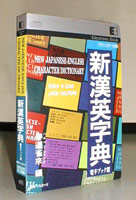 The New
Japanese-English Character Dictionary is a totally new reference work designed to enable the
learner to gain an in-depth understanding of how Chinese
characters are used in contemporary Japanese.
The New
Japanese-English Character Dictionary is a totally new reference work designed to enable the
learner to gain an in-depth understanding of how Chinese
characters are used in contemporary Japanese.  The New
Japanese-English Character Dictionary is a totally new reference work designed to enable the
learner to gain an in-depth understanding of how Chinese
characters are used in contemporary Japanese.
The New
Japanese-English Character Dictionary is a totally new reference work designed to enable the
learner to gain an in-depth understanding of how Chinese
characters are used in contemporary Japanese.
Normally, the student faces the task of learning countless compound words as unrelated units. A unique feature of this dictionary that helps overcome this difficulty is the presentation of a central or core meaning, a concise English keyword that defines the most dominant meaning of each character, followed by detailed character meanings that clearly show how a few thousand basic building blocks are combined to form the several hundred thousand compounds in Japanese.
 To
further aid the learner, clear, complete, and accurate character
meanings, illustrated by numerous compounds and examples, are
grouped around the core meaning in a logically-structured manner
that allows them to be conceived as an integrated unit. To make
the dictionary a tool of real precision, it also provides full
guidance for distinguishing between easily confused characters
(synonyms and homophones).
To
further aid the learner, clear, complete, and accurate character
meanings, illustrated by numerous compounds and examples, are
grouped around the core meaning in a logically-structured manner
that allows them to be conceived as an integrated unit. To make
the dictionary a tool of real precision, it also provides full
guidance for distinguishing between easily confused characters
(synonyms and homophones).
Another unique feature is the introduction of SKIP, a new indexing system that enables the user to locate entries as quickly and as accurately as in alphabetical dictionaries. Since the system can be learned in a very short time and does not require prior knowledge of kanji elements, this dictionary is an extremely convenient and easy-to-use reference tool.
Various other features distinguish this as the most in-depth Japanese- English character dictionary ever compiled.
 The Kodansha Kanji Learner's Dictionary
answers the urgent need for an easy-to-use kanji dictionary,
compact enough to be easily carried around, yet detailed enough
to satisfy the practical needs of the serious learner.
The Kodansha Kanji Learner's Dictionary
answers the urgent need for an easy-to-use kanji dictionary,
compact enough to be easily carried around, yet detailed enough
to satisfy the practical needs of the serious learner.
Its basic goal is to give the learner a thorough understanding of how kanji are used in contemporary Japanese by providing instant access to a wealth of useful information on the meanings, readings, and compounds for the most frequently used kanji.
A unique and valuable feature is the core meaning, a concise keyword that defines the most dominant meaning of each character, which is followed by in-depth meanings that clearly show how a few thousand basic building blocks are combined to form countless compound words.
Clear, complete, and accurate character meanings, illustrated by numerous compounds and examples, are grouped around the core meaning in a logically structured manner that allows them to be perceived as an integrated unit. In addition, guidance is provided for distinguishing between easily confused characters, such as homophones.
Another unique feature is the System of Kanji Indexing by Patterns (SKIP), an indexing system that enables the user to locate characters as quickly and as accurately as in alphabetical dictionaries. Since the system can be learned in a very short time and is easy to use, this dictionary is an extremely convenient learning tool.
Modern linguistic theory has been effectively integrated with sophisticated information technology to produce a powerful tool that can be used by beginning and intermediate learners with equal ease. For the first time, learners of Japanese have at their fingertips a wealth of information on kanji that is linguistically accurate, easy to use, and carefully adapted to their practical needs.
Thanks to these and other features, this is the most useful Kanji-English learner's dictionary ever compiled.
Nichigai Associates (1995) (More Info)
 The
Electronic Book (EB) edition of New Japanese-English Character
Dictionary (NJECD) is the latest addition to KIT (Kanji
Integrated Tools) -- a series of computer-edited dictionaries and
other useful learning aids for mastering Japanese. The new
dictionary is based on the first installment of the series, the
NJECD, which has already become established in Japanese language
education circles as a standard reference work.
The
Electronic Book (EB) edition of New Japanese-English Character
Dictionary (NJECD) is the latest addition to KIT (Kanji
Integrated Tools) -- a series of computer-edited dictionaries and
other useful learning aids for mastering Japanese. The new
dictionary is based on the first installment of the series, the
NJECD, which has already become established in Japanese language
education circles as a standard reference work.
The EB edition incorporates most of the features of its parent work, including core meanings, independent words, homophone/synonym discrimination, compounds, radicals, and a kanji thesaurus. A hierarchical menu system enables the user to easily retrieve information by specifying single or multiple keywords, such as readings, radicals, core meanings, SKIP patterns and stroke-count. This, combined with a comprehensive cross-reference network, provides the user with multiple search paths to access information with maximum speed and facility.
This dictionary brings together in a convenient handbook format the major national and corporate character set codes of the CJK characters defined by ISO/IEC 10646. Each character is given mappings to the principal national and regional standards as well as references to the Morohashi and Kangxi dictionaries, readings in Japanese, Mandarin, and Korean, and variant information. It also include an extensive introduction to character encoding as well as various appendices and indices for readings and codes of national standards.